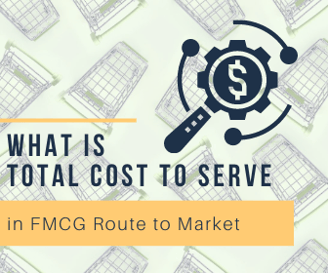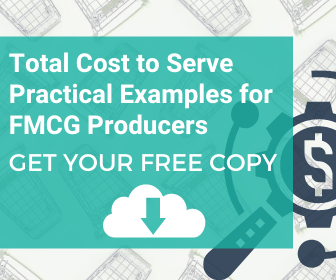Understanding the Total Cost to Serve our customers is an essential element to any Route to Market (RtM) Strategy. As FMCG professionals, we need to understand how much it costs us to service our customers. It is also not as simple as it sounds.
Why do we need to define the TCTS for our customers?
There are many reasons, for example, we may want to set a minimum order quantity based on margin vs TCTS, so that we have a guaranteed minimum margin. These include:
- We may want to bonus our RtM team based around TCTS targets.
- We may want to reward or incentivise customers or distributors around TCTS.
- We may want to establish certain customer service levels.
 We may look at changing our RtM, for example, moving from a passive importer model to an active in-market model, or from an indirect RtM to a direct model, or vice versa, or a different combination of either, and we will want to understand the TCTS.
We may look at changing our RtM, for example, moving from a passive importer model to an active in-market model, or from an indirect RtM to a direct model, or vice versa, or a different combination of either, and we will want to understand the TCTS.
There are a multitude of reasons, but at a most basic level, we want to understand the TCTS, so we can drive it down, whilst growing sales.
Different organisations define TCTS in different ways, and it is heavily dependent on your RtM Strategy and more specifically your DIME Approach (Direct, Indirect, Mix & Everything in between) Approach.
At its most basic level, TCTS is identifying the total cost of servicing your customers. However, when building a TCTS model you will need to include, and fully understand the impact of the following key areas:
Customer
- Have we mapped out all potential costs across our supply chain and RtM?
- Is there a point in the supply chain/RtM after which you begin to treat your product differently depending on specific customer’s needs or classification?
- Have we identified this for all customers or groups of customers?
- Have we mapped out costs common to all customers vs customer specific costs?
- Do we accept product returns from all customers?
- What are the costs associated with these?
- Do we have customer specific bonuses or payments?
Brand
- Do you have specific brands for specific customers or groups of customers?
- Do certain brands fall inside or outside any potential MOQ (Minimum Order Quantity)?
- What are the costs associated with these?
Pack
- Do you supply specific SKU types or sizes to certain customers?
- For supply chain, marketing or other reasons have we mandated certain pack formats to certain customers or channels?
- What are the costs associated with these?
Channel
- Do you have different rewards, incentives, discounts, or customer rebates based on different channels?
- Are there any reasons we may have a different margin per channel?
- If so, what are they?
- Are all promotions common across all channels?
- Do we have a common price list across all channels?
- Is your RtM the same for each channel? If not, what is the impact on TCTS?
- Do some of your MT outlets do central distribution? If so, are MT rewards aligned to potential distribution costs/savings?
Region
- Do you service all regions or geographies in the same way?
- How do, for example, urban vs rural costs differ?
- What are the sales incentives per region and how does this impact on TCTS?
Digital
- Do we allow and facilitate RSO (Retailer Self Ordering)?
- Do we have an online or Digital portal for our customers?
- How does eCommerce effect our TCTS?
- Do we use a digital solution to have end-to-end total supply chain and RtM visibility?
- What are the costs associated with these?
Supply Chain
- Do we have an agreed company approach to TCTS? If not, how will we achieve this?
- Do we have a MOQ?
- Is the MOQ aligned to specific customer, channel, region and order frequency costs and service levels?
- Do we have optimised customer routing?
- Do we service our customers directly? If so, what are the costs per drop, per customer?
- If we service our customers indirectly, what are the costs per drop, per customer?
Order Capture & Frequency
- Does a distribution, van sales or trade marketing representative visit the customer to take the order?
- Does a telesales or telemarketing representative phone for the order?
- What are the call frequencies of these representatives and are they aligned to order frequency?
- Are these different reps (distribution, van, trade marketing, telesales, telemarketing, etc.) working directly for our company or for a distributor?
- What is the cost per order in each scenario?
- What is the order frequency and size per customer?
Invoicing & Payment
- How does the customer pay?
- Do all customers pay on time?
- Do we accept cash?
- Do we have ePayment options?
- What are the levels of bad debts?
Analysis
- How do costs in each of the channels compare?
- What does a cost per customer analysis look like?
- Does the cost per customer analysis show a difference, for example, per channel, per pack, per region, etc?
After you have assessed your current RtM approach, and based on the above key areas, you will then need to design and build your specific TCTS model. To those of you who would like to understand a bit more about various TCTS models we have just released our free guide Total Cost To Serve (TCTS) – Practical Examples for FMCG Producers.
Now is the time to be doing this analysis and understanding as you prepare to take the necessary actions. The 2021 winners in your market are doing it now. If you need help or flexible resources, please reach out to me directly.








